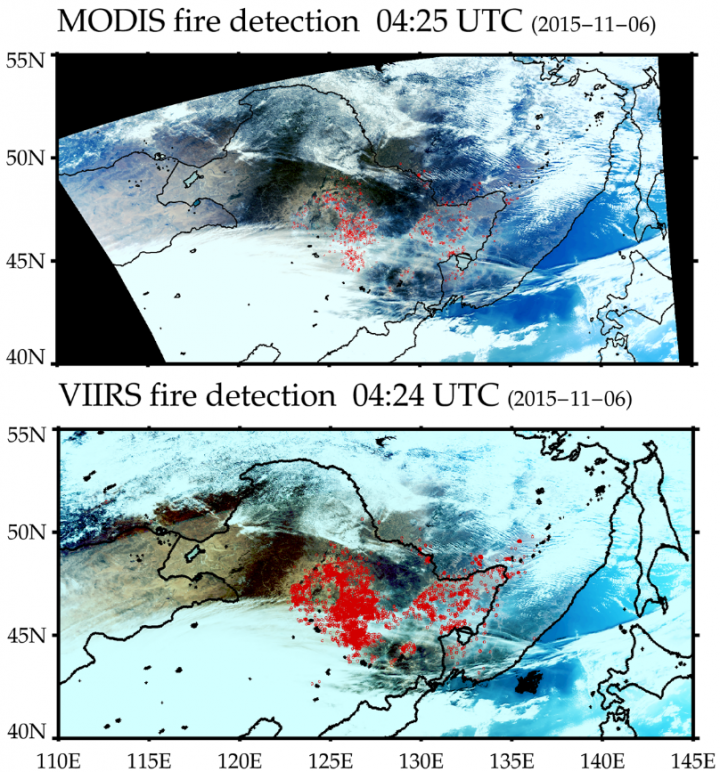| homepage News and Events News Releases |
| International Cooperative Study on Satellite Remote Sensing of Wildfire |
| Date: 2020-09-08 Author: SKLFS Source: SKLFS |
Satellites are able to provide regional to the global observation of fires at relatively high spatiotemporal resolution. In the past several decades, satellite observation has been widely used in fire monitoring, fire regimes, and fire emission studies, relying on accurate fire observation such as fire detection (omission and false alarms) and fire intensity. Assessing the performance of fire observations between satellites, thus, is very important for associated fire studies. Recently, Prof. Rui Li from the State Key Laboratory of Fire Science, University of Science and Technology of China (USTC), in cooperation with Prof. Yves Bergeron (fellow of the Royal Society of Canada (Academy of Science)) and Prof. Osvaldo Velaria from the University of Quebec in Abitibi-Témiscamingue (UQAT), conducted a comparison study of fire observation between the Moderate Resolution Imaging Spectroradiometer (MODIS) and its successor the Visible Infrared Imaging Radiometer Suite (VIIRS) to explore their relative performance on fire detection and fire intensity monitoring in Northeast Asia. Associated results were organized and published at the journal of Remote Sensing (IF=4.5, 5-year IF=5.0) with the title of Fire Detection and Fire Radiative Power in Forests and Low-Biomass Lands in Northeast Asia: MODIS versus VIIRS Fire Products. The study showed that both MODIS and VIIRS missed some fires and have some false fire alarms. The fire detection omissions are more common over low-biomass lands (e.g. grassland and croplands) than forests (Figures 2), and are more significant for MODIS than for VIIRS, especially in low-biomass lands (Figures 2). The higher fire omission errors of MODIS than VIIRS are mainly attributed to its coarser spatial resolution (1 km at nadir) than VIIRS (375 m). With lower spatial resolution, it is more difficult for MODIS to distinguish fire signal from background in space especially considering its rapidly increasing pixel size along scan angle. On the other hand, the prevalence of low fire intensity in low-biomass lands can lead to more fires that are detectable for VIIRS below the detection capability of MODIS, explaining the significantly higher fire omission of MODIS than VIIRS in low-biomass lands. The commission errors (false fire alarms) are also existed for both MODIS and VIIRS, and are closely related to the vegetation types and the FRP value of the ‘fire pixel’ retrieved. As for fire intensity, MODIS FRP retrieval is higher than that of VIIRS for those concurrently detected fires (Figures 2). One of the reasons is likely due to the attenuation of atmospheric absorption of carbon dioxide (CO2) at the VIIRS M-13 channel (3.97–4.13 μm) that was used for FRP calculation. Another possible reason is the higher background temperature estimation with VIIRS than MODIS during the calculation of fire FRP. However, there were many fires detected by VIIRS that MODIS omitted; these extra fire detections offset the effect of the lower FRP retrieved by VIIRS for those concurrently detected fires and finally led to an overall higher total FRP with VIIRS than MODIS (Figure 2). The above results will contribute to a better understanding of fire detection and FRP retrieval performance between MODIS and its successor VIIRS, providing valuable information for using those data in the study of fire regimes and FRP-based fire emission estimation. The work was supported by the National Natural Science Foundation of China (NSFC), the China Scholarship Council (CSC), and the Belmont Forum and JPI-Climate Collaborative Research Action with NSFC.
Figure 1. Fire case detected almost simultaneously by MODIS and VIIRS
Figure 2. (a, b) MODIS and VIIRS fires with and without co-located fire detection from each other; (c, d) VIIRS versus MODIS monthly FRP during 2012–2017.
View full text: https://www.mdpi.com/2072-4292/12/18/2870 Author homepage: http://ess.ustc.edu.cn/faculties/detail-58.html Email rli7@ustc.edu.cn Signed: Prof. Rui Li and Naian Liu at the State Key Laboratory of Fire Science, University of Science and Technology of China |
|
|
||
|
|
| Relevant link | ||
|
|
|
||||||||||
|
||||||||||

